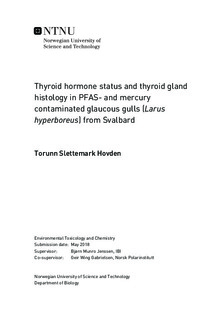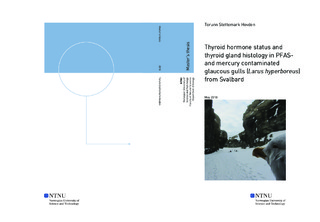| dc.description.abstract | The glaucous gull (Larus hyperboreus) is a scavenger and top predator in the Arctic marine food web. Due to its high trophic position, it is highly exposed to organohalogenated compounds (OHCs) and metals originating from anthropogenic emissions. The high body burden of contaminants is believed to cause adverse health effects, which assumingly affect the species even at the population level. The aim of this project was to investigate the possible effects of per-and polyfluoroalkyl substances (PFASs) and mercury (Hg) on the thyroid hormone system, as expressed by circulating thyroid hormone (TH) and thyroid stimulating hormone (TSH) levels, as well as the histology of the thyroid gland.
Fifteen glaucous gulls were euthanized in Sassendalen and Adventfjorden in Svalbard during the pre-breeding period in April and May 2017. Samples were taken of plasma, feathers, liver, and thyroid gland. PFAS concentrations were quantified in the liver, whereas Hg concentrations were quantified in the liver, feathers, and plasma. TSH and total and unbound fraction of TH were quantified in plasma. As selenium (Se) plays a role both in activation and regulation of THs, and acts as a detoxifying agent for Hg, this element was analysed in the same tissues as Hg. The histology of the thyroid glands was examined for histological changes. Multivariate data analyses were conducted to evaluate associations between Hg, PFASs and thyroid response variables.
Perfluorooctane sulfonate (PFOS) was the dominating PFAS, accounting for 71 % of the PFAS load. Long-chained perfluorinated carboxylates (PFCAs) constituted the remaining 29 % of the load, and there were no major differences between male and female glaucous gulls. Hg levels were highest in feathers of males, whereas liver and plasma concentrations were similar in males and females. Se levels were higher than Hg levels in plasma, feather and liver samples. Normal thyroid tissue was seen in five of fourteen birds. Eight birds had epithelial cell proliferation, and nodular hyperplasia was seen in one bird. The results indicate that Hg might contribute to a high follicle count in thyroid glands. TSH was negatively correlated with PFOS and perfluoro tetradecanoate (PFTeDA), and positively correlated with Se:Hg in liver (all, n=15) and plasma (males, n=7). Overall, the results from the present study indicate that ecological exposure to PFASs and Hg may alter thyroid hormone economy and thyroid histology in glaucous gulls in Svalbard. | |

